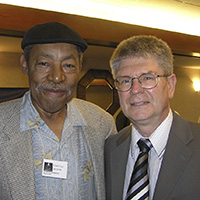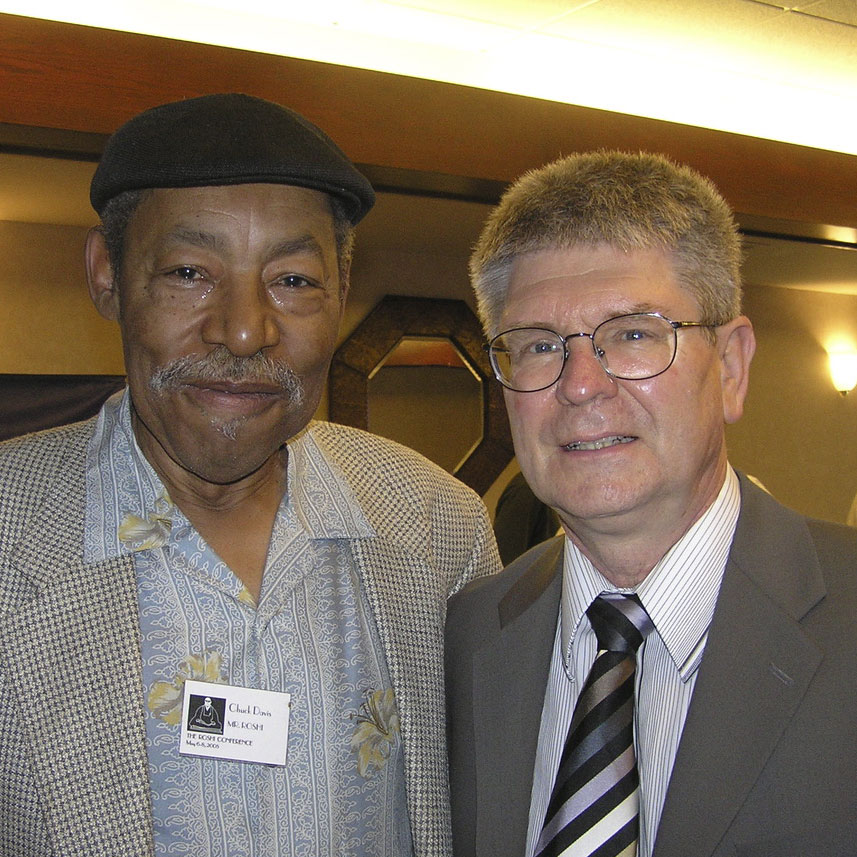On my Professional Partnership with Chuck Davis
by Victoria Ibric, M.D. | September 5th, 2017
Charles Jefferson Davis, affectionately known as Chuck, was born an engineer. At an early age, he spent his time taking things apart to see how they worked. As a boy, he rigged the household phone to talk to people around the world without the help of the phone company. He worked for companies such as NASA’s JPL (Jet Propulsion Laboratory), Lockheed, and others. He was a brilliant engineer that some called the “Black Einstein.” At some point in his life, he decided to focus his efforts on creating something that would make a more direct positive difference in people’s lives. As the inventor of the ROSHI I & II and the pROSHI, he has helped thousands unscramble the anomalies of their brains over the years. This non-drug, non-invasive procedure that he eventually called the Neurodynamic Activator® far exceeded the capabilities of any instrumentation of its kind, and it came along well before its time.
Chuck was a man of many talents. Excited about all things mechanical, Chuck was also a “car guy” who spent considerable time as a race car driver—even racing in the Malibu Classics. He souped up his Mercedes to get better gas mileage and to make it run faster. He was also fascinated by aeronautics and held a pilot’s license.
Chuck was an accomplished musician who worked as lead engineer at Motown in Detroit, Michigan. With extensive experience as a songwriter, music composer and band member, he worked with artists such as the Blackbyrds, Michael Jackson, Bobby Humphries, Diana Ross and Donald Byrd. Chuck played three instruments; the piano, the flute, and the piccolo.
Chuck took great pleasure in helping people, and that opportunity presented itself in abundance with the ROSHI. In fact, the pROSHI was originally created to help a band member. It became his signature invention, helping countless people around the world and creating a devoted user community whose members proudly proclaim themselves as “Roshinis”. He himself derived great satisfaction from watching people’s expression change on their first exposure to the ROSHI.
Chuck enjoyed a 48-year companionship with Audrey Bowen, whose family was engrafted into Chuck’s heart. He forged a long-term business relationship with Dr. Victoria Ibric, who was his first practitioner and strongest supporter. Ultimately his family became the many clients and supporters known as his “ROSHI family.”
Chuck and I met at the Biofeedback Institute of Los Angeles (BILA), where he was working for Hershel Toomim, building components for the Biocomp biofeedback system. We took EEG biofeedback classes together at EEG Spectrum in Encino, with Sue and Siegfried Othmer. At that time, I had no idea who Chuck was. A year later, after becoming more involved in the EEG Biofeedback at BILA, I had the chance to be the first guinea pig for the original ROSHI system. One day, Chuck came in with a diskette that he inserted in the Amiga feedback computer of my NeuroCybernetics system. My experience was more than remarkable. First, the red light from my glasses were stimulating my closed eyes through my eyelids. Soon I observed that the colors were changing, from red to yellow to purple to turquoise, so I asked him why was he changing the colors on me. He laughed and said: “That is your own perception of your own brain wave frequencies changing!” Then I felt a cold tear coming out of my left eye, and suddenly I felt very peaceful. At the end of this experiment, I felt that my body was losing weight and it started to detach from the chair I was sitting in, floating. A moment of anxiety came over me and I told Chuck: “Please get me down now!” All these various feelings during my first ROSHI session made me curious to use it more for myself, and eventually with my clients. That was the beginning of a new friendship between Chuck and me that has lasted a quarter of a century.

Chuck Davis with Siegfried Othmer at the ROSHI Conference in May, 2006
I started to use ROSHI with clients who were not responding fast enough to the NeuroCybernetics system and I took very detailed notes of their progress, for research purposes. Many of my clients’ results became case studies presented at various conferences over the years.
After understanding more and more of how ROSHI worked, I presented workshops to many of our colleagues at Winter Brain meetings, ISNR, AAPB, BSC-WABN, ECNS, APA and I also offered internships, from 1998 until the present.
Chuck Davis has forever left his imprint on the world of Neurofeedback. He was brilliant, creative–and occasionally also difficult with some of us. But what would we have done without him? I know this from my own experience and that of other therapists: countless numbers of people have been helped all over the world by his elegant ROSHI-Neurofeedback system, his NeuroDynamic Activator(R)-personal ROSHI trainer. They would have had much more difficult lives, or perhaps might not even have survived, without that intervention. His legacy will live on!
References
Ibric, V.L. and Charles J. Davis. (2007) “The ROSHI in Neurofeedback” chapter 8 IN: Handbook of Neurofeedback: Dynamics and Clinical Applications, ed. James Evans, pp 185-211. Published by The Haworth Press, Inc., NY. ISBN 978-0-7890-3360-4
ROSHI Anthology I – Enhancing Neurofeedback Training Experience & Results Using ROSHI Systems. Victoria L. Ibric (ed.. and contributor) Copyright 2014, ISBN 978-0-9909246-0-9
Neurofeedback in Major Depression Associated to Addictions – a case study, presented at 6th Annual Meeting of SNR, Austin, TX, Ibric, V.L.(1998).
Various diagnostic cases treated with Roshi/Neurocybernetics – preliminary results, presented at 6th Annual Meeting of SNR, Austin TX,Ibric, V.L., Kaur, S. and Davis, C.J. (1998).
AVS/EEG Training on ROSHI/BrainLink® Instrument and Protocols, workshop presented at the 7th Annual Meeting of SNR, Myrtle Beach, SC., Ibric, V.L., and Davis, C.J. (1999).
Pain and Neurofeedback- Corticalization of Pain and Modification of Pain Affect through Neurofeedback and the use of Roshi/AVS. Workshop presented at 8th Winter Brain Conference 2000, Palm Springs, CA, Ibric, V. L., Davis, C.J. (2000).
Long-Lasting Effects of Neurofeedback Training on Bipolar Disease and Addictions-(follow-up case study), Lecture presented at Winter Brain Conference, Palm Springs, CA, Ibric, V.L. (2000).
Neurofeedback Enhanced by Closed Loop-EEG using Complex Adaptive Modality Improves Hand Control Movement in a case of Essential Tremor. Presentation Handout from the 8th Winter Brain Annual Conference, Miami, FL. Ibric, V.L. (2001). (Presented by Dr. Cory Hammond)
Roshi/BrainLink® Protocols III. Neurofeedback enhanced by light closed-loop EEG and by electromagnetic closed- loop EEG. Workshop presented at 9th Annual Conference of Society for Neuronal Regulation, Monterrey, CA, Ibric, V.L. (2001).
Neurofeedback enhanced by light closed-loop EEG and electromagnetic closed-loop EEG in a case of sleep deprivation post Methadone withdrawal. Poster presented at 9th Annual Conference of Society for Neuronal Regulation, Monterrey, CA, Ibric, V.L. (2001).
Neurofeedback enhanced by light closed- loop EEG in depression and addictions, presented at AAPB Las Vegas, NV, Ibric, V.L.(2002).
Neurofeedback enhanced by Light & Electromagnetic closed-loop EEG-Applications, workshop presented at, AAPB, Las Vegas, NV, Ibric, V.L., Olesen, E. (2002).
Neurofeedback Training Enhanced by Light and/or Electromagnetic Closed Loop-EEG Induces Analgesia in Patients with chronic Pain, presented at IASP Conference, San Diego, CA, Ibric, V.L. (2002).
Neurofeedback enhanced by light and electromagnetic closed loop EEG in Parkinson’s Disease. Lecture presented at 10th Annual Conference of Society for Neuronal Regulation, Scottsdale AZ, Ibric, V.L.(2002).
ROSHI as a Diagnostic Tool, Workshop presented at 10th Annual Conference of Society for Neuronal Regulation, Scottsdale AZ, Ibric, V.L.,McCourt, J.L. (2002).
ROSHI/BrainLink® protocols – IV. Workshop presented at 10th Annual Conference of Society for Neuronal Regulation, Scottsdale AZ, Ibric, V.L. (2002).
QEEG and ROSHI use in Autism post toxic encephalopathy- a case study. Presented at Winter Brain Conference, Palm Springs, CA, Ibric, V.L., Hudspeth, W.J. (2003).
ROSHI and applications – longitudinal studies. Workshop presented at Winter Brain Conference, Palm Springs, CA, Ibric, V.L. (2003).
ROSHI training and its validation. Presented at BSC, Irvine, CA, Ibric, V.L. (2003).
Changes in EEG Coherence, Workshop presented at Winter-Brain Conference, Palm Springs, CA, Ibric, V.L. and Hudspeth, W.J. (2004).
Bipolar Depression and Addictions- Seven Year Success.California Biofeedback Newsletter, Volume 20, No.1, pgs 6-7, Ibric, V.L.(2004).
Current Concepts: Real-time images of QEEG operant conditioning, Workshop presented at AAPB Conference, Colorado Springs, CO, Ibric, V.L. and Hudspeth, W.J. (2004).
qEEG and Behavioral Indices for Neurofeedback Effectiveness, presented at the ECNS conference in Irvine, and in proceedings of the Journal of ECNS Conference, Vol. 5, No 4, pp 213-214. Ibric, V.L. (2004).
Enhanced Types of Neurofeedback, Lecture presented at Winter Brain Conference, Palm Springs, CA, Ibric, V.L. (2005).
QEEG and ROSHI Use in a Case of Autism, post Encephalopathy. ROSHI Journal, Vol. 2 No 2 pp 2-13, Ibric, V.L. and Hudspeth W.J. (2005).
Validation ROSHI with QEEG – Introduction to the Principles and Practices in NeuroNeuronal Rehabilitation. The Proceedings of the 35th Annual meeting of the AAPB, Austin, TX, Hudspeth, W.J. and Ibric, V.L. (2005).
QEEG and ROSHI- Introduction to the Principles and Practices in Neuronal Rehabilitation WS 1st Annual ROSHI Conference, Pasadena, CA, Hudspeth, W.J. and Ibric, V.L. (2005).
Learning ROSHI, WS 1st Annual ROSHI Conference, Pasadena, CA, Ibric, V.L. (2005).
64. ROSHI Enhanced Neurofeedback type of training, WS iSNR, Denver CO, Ibric, V.L. (2005).
QEEG Connectivity: From Assessment to a new Metric of Therapeutic Change. iSNR, Denver CO, Ibric, V.L., Hudspeth, WJ, and Coben, R. (2005).
Longitudinal studies of Neurofeedback efficacy. BSC Annual Meeting. Irvine, CA, Ibric, V.L. (2005).
Current issues in Neurofeedback. Panel at the BSC, 31st Annual conference, Irvine, CA, Gunkelman, J., Othmer, S., Ibric, V.L. and Linden, M. (2005).
ROSHI & pROSHI in a case of Chronic Pain. ROSHI Journal Vol. 3 No 1, pp 1-7, Ibric, V.L. (2006).
A first case of anxiety disorder treated with Neurofeedback in Romania, presented at iSNR, Atlanta, GA, Ibric, V.L. and Dragomirescu, L.G. (2006).
Evaluation of the NF training by using QEEG and HEG – a workshop, presented at iSNR, Atlanta, GA, Ibric, V.L. (2006).
EEG Real-time changes during the enhanced Neurofeedback by using Neuro-Dynamic Activators™ Presented at the Psychotherapy Networker Symposium W.DC, Ibric, V.L. (2008).
Real-time Changes in Connectivities During Neurofeedback. J of Neurotherapy, 13:156-165, Rutledge, Taylor & Francis Group, Ibric, V.L., Hudspeth, W.J. and Dragomirescu, L.G. (2009).
The first case of Nystagmus and Amblyopia trained with NF in Romania, presented at the 41st AAPB Annual meeting, San Diego, CA, Ibric, V.L. and Dragomirescu, L.G. (2010).
Neuro-Rehabilitation Effectiveness: Study of the Neurodynamic-Activator ™as a standalone device. (Course) presented at the 41stBSC (WABN-Western Association for Biofeedback and Neuroscience) Annual Conference, Costa Mesa, CA, Ibric, V.L, and Owes, M. (Nov 7-9, 2015).





